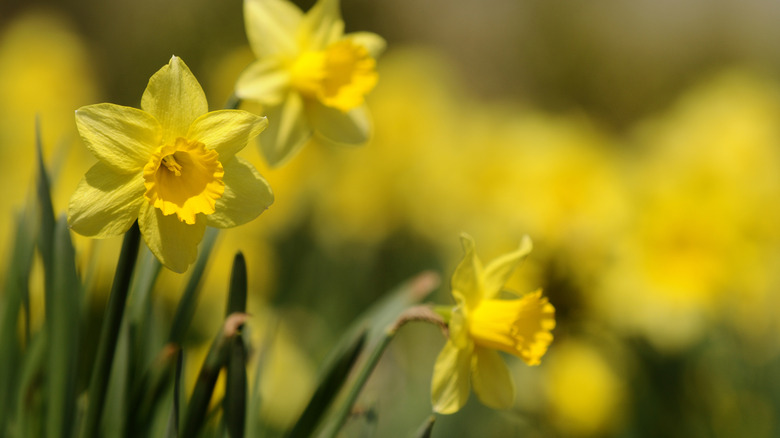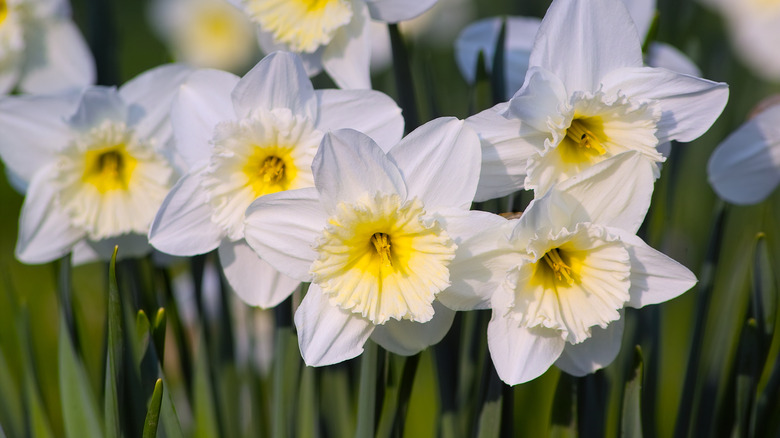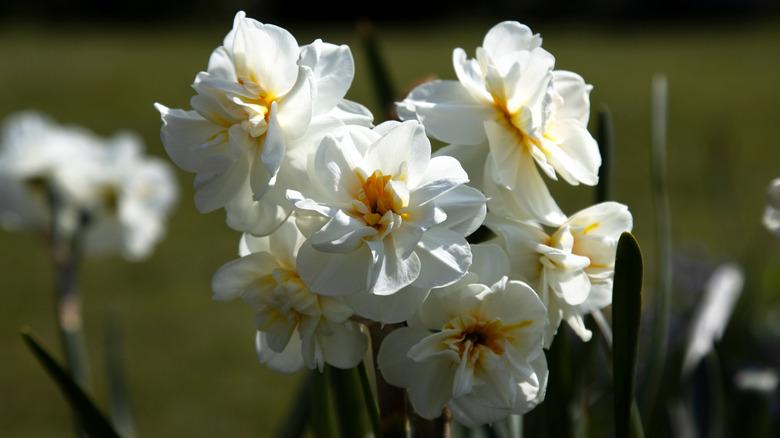The Key To Picking The Right Daffodils To Plant In Your Growing Zone
Daffodils (Narcissus spp.) are cheerful flowers that are synonymous with spring and the arrival of warmer temperatures. These hardy perennials are known for withstanding cold temperatures, overwintering as bulbs underground before emerging in the spring. Most daffodils are suited to USDA hardiness zones 3 through 7, where temperatures drop sufficiently through the winter, providing a chill period that initiates root growth. However, some daffodil species do well in warmer climates with mild winters. To choose the right variety and ensure the most healthy bloom, understanding which daffodils require a chill period is key.
Daffodil flowers are characterized by their distinctive trumpet-shaped central corona surrounded by six petal-like tepals. Golden yellow or buttermilk-colored flowers are considered the quintessential daffodils, but cultivars range from white to pink and orange. Depending on the species, the stems can be either short or long, with slender, sword-shaped leaves emerging from the base of the plant. Daffodils prefer moist, well-draining soil and a location that receives plenty of sun. Understanding your climate as well as the particular daffodil variety you've chosen are just two simple ways you can avoid mistakes when planting daffodils.
Daffodils that require a chill period: USDA zones 3-7
If you live in USDA hardiness zones 3 through 7, you have a wide range of daffodils to choose from. Like many spring-blooming bulbs, most daffodils require a chilling period of at least 12 to 15 weeks in order to break dormancy and initiate flower development. Growing daffodils that require a chilling period in warmer climates may lead to delayed blooming, stunted growth, or short stems, so don't plant these types in zones above 7. October is the best time of year to plant daffodils in these cooler areas — it provides a sufficient chill period while allowing the bulbs to begin developing roots before the ground freezes.
Hardy down to zone 3, Narcissus Ice Follies produce large, creamy white to lemon-colored flowers, while Salome bears large, creamy white tepals and a yellow to peach central trumpet. Choose Narcissus Tahiti for ruffled, double flowers in yellow or Mount Hood for an ethereal, all-white option. The quintessential golden yellow Peeping Tom cultivar is also a great option for growing in zones that provide a chill period over winter.
Daffodils that don't require a chill period: USDA zones 8-9
There are also several choices for growing daffodils in warmer, southern climates. These species don't require a chill period, so they're suited to climates with mild winters where temperatures may not drop sufficiently for 12 to 15 weeks. In USDA hardiness zones 8 through 9, you may be able to plant your daffodil bulbs a little later in the fall or even in early winter. What's important is to plant the bulbs before the first frost to support developing a root system. Although temperatures rarely drop below freezing in zone 9, zone 8 climates may still experience frost or frozen ground — plant daffodil bulbs by early November in zone 8 and up to early December in zone 9.
Tazetta daffodils flower prolifically, producing clusters of up to 20 blooms per stem. Great cultivars for warmer growing zones include Avalanche's white and yellow blooms or Erlicheer, which produces an abundant display of double-flower clusters. Jonquil daffodils produce charming, small flowers less than 1 inch in diameter. They are drought- and heat-tolerant, making them perfect for southern climates. Choose Bell Song for a white and rose pink display or Sun Disc for golden yellow blooms. Note that although these cultivars don't require a chill period to initiate flowering, they will still tolerate below-freezing temperatures. Hardy down to zone 4 or 5, most tazetta and jonquil daffodils can tolerate as low as -10 to -15 degrees Fahrenheit.



